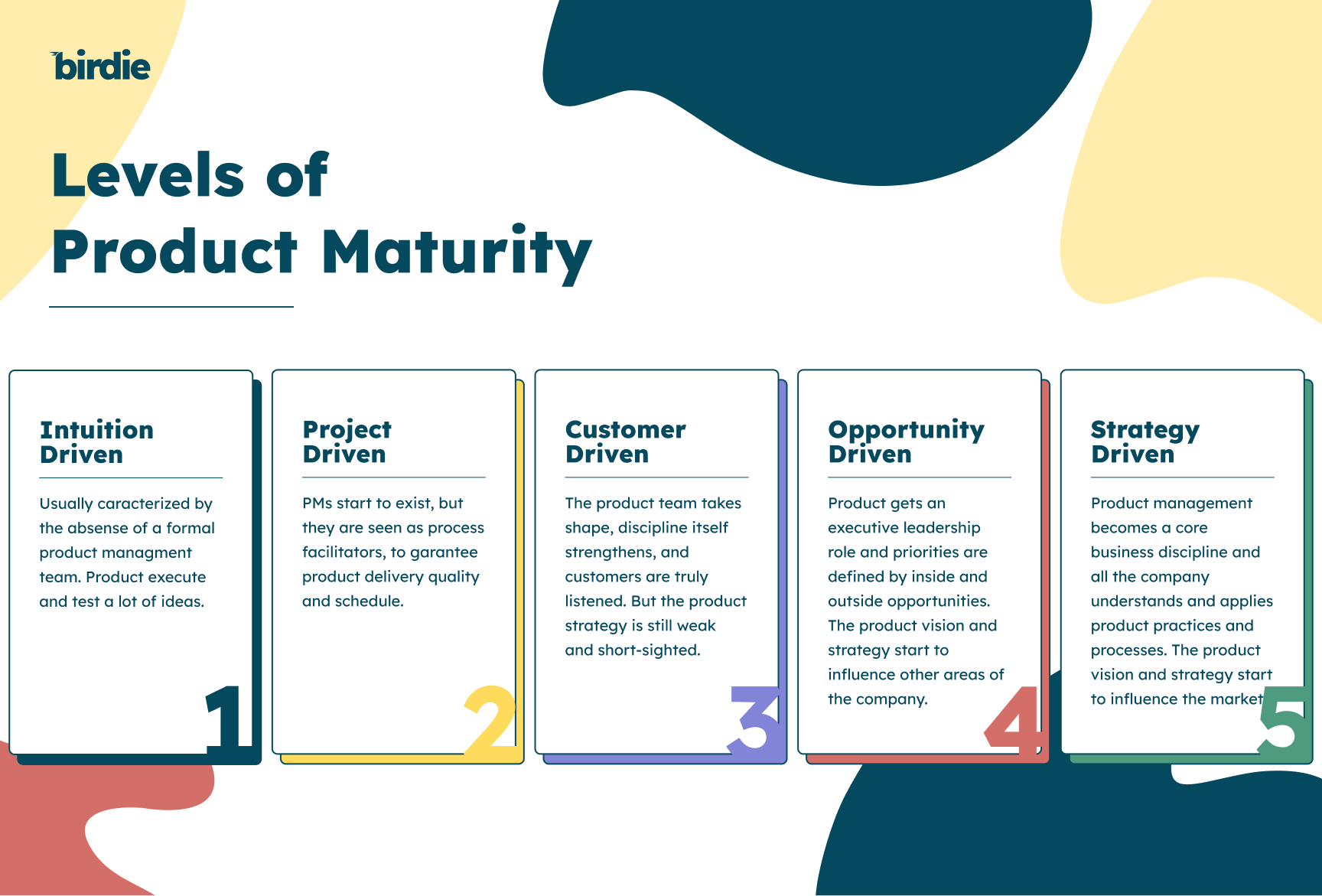The Ultimate Guide to Understanding the Product Maturity Model

In the competitive world of product development, understanding the Product Maturity Model is essential for success. This comprehensive guide aims to provide you with an in-depth understanding of this model and its key components. We will explore the stages of the Product Maturity Model and discuss strategies for navigating each stage. Additionally, we will delve into the role of the Product Maturity Model in business strategy and explore future trends in this field.
Defining the Product Maturity Model
The Product Maturity Model is a framework that assesses the lifecycle of a product, from its introduction to its decline. It helps organizations understand the development and adoption of a product in the market. By recognizing the different stages a product goes through, businesses can make informed decisions and allocate resources effectively.
When a product is first introduced to the market, it goes through a phase of introduction and early adoption. During this stage, the product is new and unfamiliar to customers. Companies often invest heavily in marketing and promotion to create awareness and generate interest. The adoption rate is a key component of the Product Maturity Model during this stage. It measures how quickly customers adopt a product and at what rate. This information helps businesses gauge the success of their marketing efforts and adjust their strategies accordingly.

As the product gains traction and more customers start using it, it enters the growth stage. The adoption rate increases, and the market saturation becomes an important factor to consider. Market saturation examines the extent to which a target market is already saturated with similar products. If the market is highly saturated, businesses may need to differentiate their product or find niche markets to target. On the other hand, if the market is not saturated, there may be opportunities for expansion and capturing a larger market share.
During the growth stage, the competitive landscape also plays a significant role. As the product gains popularity, competitors may enter the market, offering similar or alternative solutions. Analyzing the competition within the market and how it impacts product growth is crucial for businesses to stay ahead. They need to continuously innovate and differentiate their product to maintain a competitive edge.
Customer satisfaction is another key component of the Product Maturity Model. Evaluating the level of customer satisfaction with the product and its features helps businesses understand how well their product meets customer needs. Customer feedback and reviews provide valuable insights for product improvement and enhancement. Companies should actively listen to their customers, address any issues or concerns, and continuously strive to exceed customer expectations.
Investment in research and development (R&D) is also a critical factor in assessing product maturity. R&D investment considers the resources allocated to enhance the product's capabilities and address market demands. By investing in R&D, companies can stay ahead of the competition, introduce new features, and adapt to changing customer preferences.
The Importance of the Product Maturity Model
Understanding the Product Maturity Model is crucial for businesses as it helps them anticipate and plan for the future. By identifying the stage a product is in, companies can tailor their strategies accordingly. It provides valuable insights into customer behavior, market trends, and anticipated demand.
This knowledge enables businesses to allocate resources efficiently, focus on the right market segments, and make informed decisions regarding product enhancements and retirements. For example, if a product is in the decline stage, businesses may need to consider phasing it out or finding ways to revitalize it. On the other hand, if a product is in the growth stage, companies can invest more resources to scale up production and expand market reach.
In conclusion, the Product Maturity Model is a comprehensive framework that helps businesses assess the lifecycle of a product. By evaluating key components such as adoption rate, market saturation, competitive landscape, customer satisfaction, and R&D investment, companies can gain valuable insights and make informed decisions. This model enables businesses to effectively manage their product portfolio, allocate resources efficiently, and stay competitive in the market.
Stages of the Product Maturity Model
The Product Maturity Model comprises four distinct stages that a product traverses during its lifecycle:
Introduction Stage
The introduction stage is the initial phase of a product's lifecycle. It is characterized by low sales volume and high marketing costs as companies focus on creating awareness and generating interest in the product. During this stage, businesses should carefully monitor customer feedback and make necessary improvements to enhance the product's value proposition.
For example, a company launching a new smartphone may invest heavily in advertising campaigns to build brand recognition and attract early adopters. They may also gather feedback from these early customers to identify any usability issues or areas for improvement.
Growth Stage
The growth stage is the period when a product starts gaining traction in the market. Sales volume and market acceptance increase significantly during this stage. As the product gains popularity, companies should aim to expand their customer base and capitalize on the growing demand.
During this stage, it is essential for businesses to invest in marketing efforts to establish a strong brand presence and gain a competitive edge. They may also consider expanding distribution channels and entering new markets to reach a wider audience.
For instance, a software company that develops project management tools may experience rapid growth as more businesses adopt their product. To leverage this growth, they might invest in targeted advertising, partnerships with industry influencers, and customer referral programs.
Maturity Stage
The maturity stage is the phase where a product reaches its peak level of market penetration. Sales growth plateaus, and the market becomes saturated with competitors offering similar products. During this stage, businesses must focus on product differentiation, customer retention, and cost optimization to sustain success.
Continued innovation and diversifying offerings are key strategies to stay ahead of the competition. Companies may introduce new features, improve product quality, or explore new market segments to maintain customer interest and loyalty.
For example, a clothing brand that has reached maturity in its market may introduce sustainable and eco-friendly materials to differentiate itself from competitors. They may also offer personalized shopping experiences or collaborate with popular influencers to attract and retain customers.
Decline Stage
The decline stage is the final phase of a product's lifecycle, characterized by a decrease in sales volume and market demand. This stage often occurs due to market saturation, technological advancements, or changing consumer preferences.
Businesses operating in the decline stage should evaluate the profitability of the product and, if necessary, develop an exit strategy or explore opportunities for product revitalization. They may consider discontinuing the product and focusing resources on new ventures or explore ways to reposition and rebrand the product to regain market relevance.
For instance, a company manufacturing traditional film cameras may face declining sales due to the rise of digital photography. In response, they may choose to discontinue their film camera line and shift their focus towards developing digital cameras or other imaging technologies.
Understanding the different stages of the Product Maturity Model is crucial for businesses to effectively manage their products throughout their lifecycle. By recognizing the unique challenges and opportunities presented in each stage, companies can make informed decisions to maximize profitability and maintain a competitive advantage.
Navigating the Product Maturity Model
To navigate the Product Maturity Model successfully, businesses should employ specific strategies for each stage:
Strategies for Each Stage
Introduction Stage: During this stage, focus on product testing, gathering customer feedback, and refining the value proposition. Engage in targeted marketing campaigns to create awareness and build interest among potential customers.
Growth Stage: Expand market reach by targeting new customer segments and exploring new distribution channels. Invest in research and development to enhance the product's features and maintain a competitive advantage. Continuously monitor customer feedback and adapt marketing strategies accordingly.
Maturity Stage: Emphasize product differentiation to stand out in a saturated market. Develop loyalty programs and strengthen customer relationships. Streamline operations to improve efficiency and reduce costs. Seek opportunities for product extensions or diversification to cater to evolving customer needs.
Decline Stage: Evaluate the product's profitability and market demand. Consider options such as discontinuation, sale, or rebranding. Explore the potential for product revitalization by targeting new customer segments or incorporating innovative features.
Common Challenges and Solutions
While navigating the Product Maturity Model, businesses often face various challenges. Here are some common challenges and potential solutions:
- Increased Competition: Analyze competitor strategies and differentiate your product through unique features, superior customer service, or pricing strategies.
- Market Saturation: Explore new markets or customer segments to expand your customer base. Focus on understanding emerging trends and adapt your product to meet those needs.
- Technological Advances: Embrace technology advancements to enhance your product's capabilities and remain competitive. Invest in research and development to stay at the forefront of innovation.
- Customer Demand Fluctuations: Stay attuned to changing customer preferences and market dynamics. Continuously gather feedback and adapt your product offering to meet evolving needs.
The Role of the Product Maturity Model in Business Strategy
The Product Maturity Model plays a vital role in shaping a company's business strategy:
Aligning Business Goals with Product Maturity
Understanding the stage at which a product resides enables businesses to align their goals accordingly. It ensures that resources are allocated effectively, and efforts are focused on areas that can drive growth and profitability.
Leveraging the Model for Competitive Advantage
By leveraging the insights provided by the Product Maturity Model, businesses can proactively adapt to market changes and gain a competitive advantage. It helps identify gaps in the market and niche customer segments that can be targeted for enhanced growth.
Future Trends in Product Maturity Models
As technology rapidly advances and markets evolve, product maturity models are expected to adapt and incorporate new trends:
The Impact of Technology on Product Maturity
Technological advancements will continue to drive changes in the way products mature. The integration of artificial intelligence, internet of things, and big data analytics will revolutionize the product development process and customer experiences.
Predicting and Adapting to Market Changes
In the future, product maturity models will become more predictive, providing businesses with early indicators of market shifts. Accessing real-time data and leveraging predictive analytics will enable companies to make proactive decisions and stay ahead of the competition.
In conclusion, understanding the Product Maturity Model is essential for businesses aiming to thrive in a competitive market. By considering key components, navigating each stage strategically, and incorporating this model into their business strategy, organizations can effectively drive growth, gain a competitive advantage, and adapt to future trends. Embrace the Product Maturity Model and unlock the true potential of your products.




